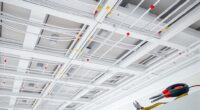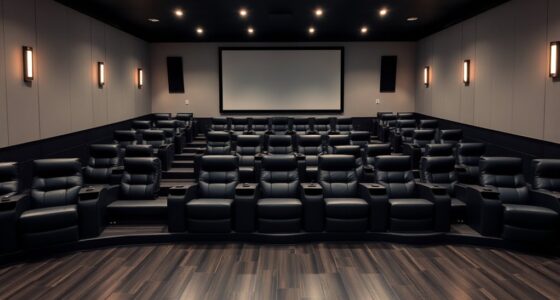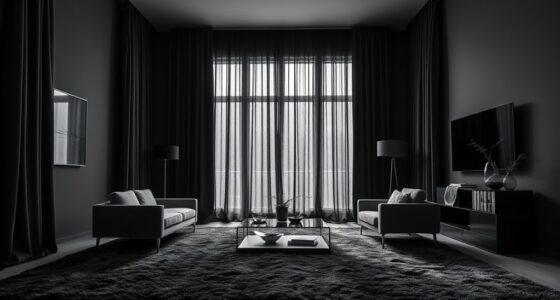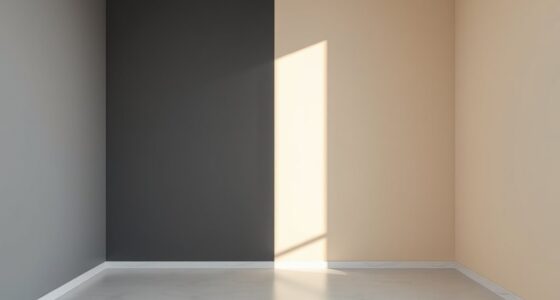To start soundproofing, clearly define whether you want total silence or just less noise, and set a realistic budget. Focus on the key disruptive sounds and prioritize solutions for those areas. Use effective materials like mass loaded vinyl and consider decoupling techniques, matching your choices to the noise type. Planning your steps guarantees you avoid wasting money on unneeded fixes. Keep exploring to discover more tips that can help you achieve better sound control.
Key Takeaways
- Clearly define your soundproofing goals to prioritize effective techniques and materials for your specific noise issues.
- Budget wisely by choosing cost-effective solutions like mass loaded vinyl and decoupling methods suited to your noise type.
- Avoid unnecessary or ineffective materials; focus on proven techniques like mass barriers and structural decoupling.
- Plan your project to target primary sound pathways, preventing vibrations and airborne noise transmission efficiently.
- Educate yourself on soundproofing principles and resources to make informed decisions and optimize results.
Identifying Soundproofing Goals and Priorities
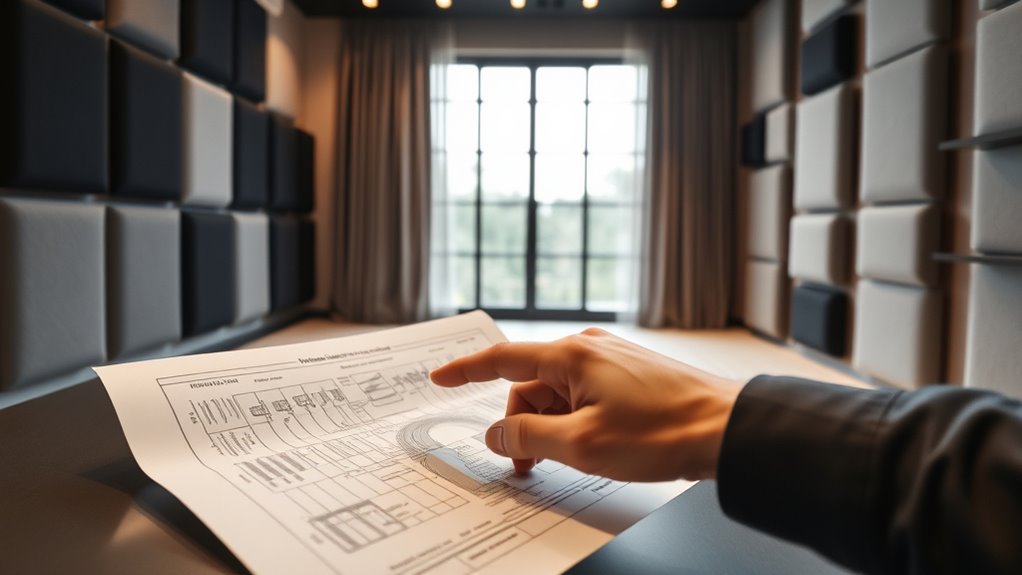
Before you begin soundproofing your space, it’s essential to clearly define your goals and priorities. Decide whether you need noise reduction strategies for complete silence or just to minimize disturbances. Your soundproofing budget will influence your choices, so establish a realistic amount you’re willing to invest. Consider which sounds are most disruptive—are you trying to block out city noise, loud neighbors, or household activities? Clarifying these priorities helps you focus on the most effective solutions. Knowing your goals allows you to select appropriate techniques and materials that fit your budget. This planning step ensures your efforts are targeted, saving you money and time while achieving the desired noise reduction. Understanding different types of soundproofing materials can help you choose the most suitable options for your needs.
Choosing Effective Materials and Techniques
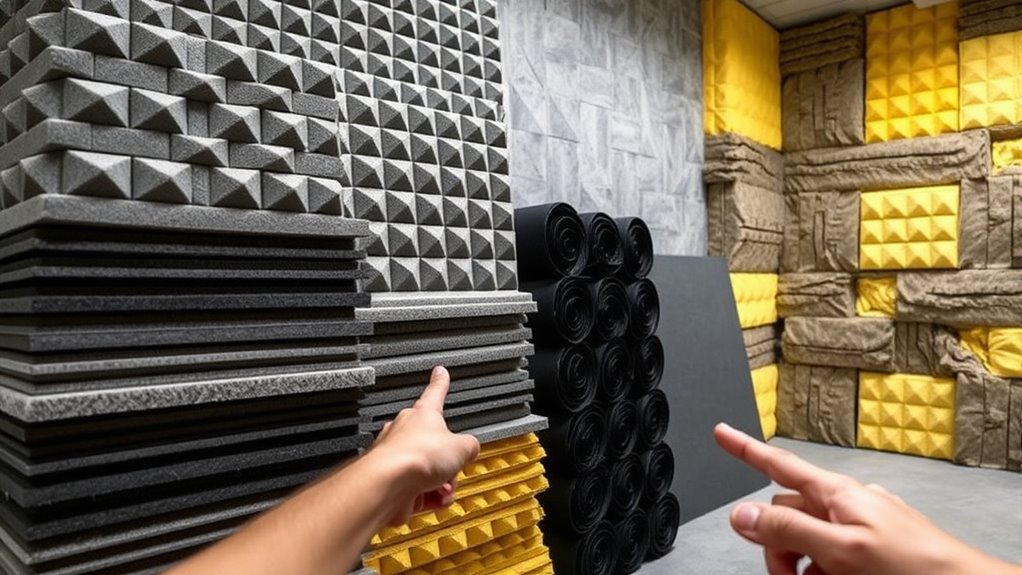
Selecting the right materials and techniques is essential for effective soundproofing, as not all options suit every situation. Using mass loaded materials, like mass loaded vinyl, adds density to walls and ceilings, blocking sound transmission effectively. Decoupling techniques, such as staggered or double-stud framing, prevent vibrations from passing through structures. These methods reduce sound transfer by creating a break in the structure’s continuity. When choosing materials, consider the type of noise you want to block—airborne or impact—and select solutions accordingly. Combining mass loaded barriers with decoupling techniques maximizes soundproofing. Additionally, understanding soundproofing principles can help you tailor your approach for better noise control. Remember, the goal is to minimize vibrations and prevent sound from traveling through walls, floors, and ceilings. Tailoring your approach with these effective materials and techniques ensures better noise control.
Frequently Asked Questions
How Much Does Professional Soundproofing Typically Cost?
Professional soundproofing usually costs between $1,000 and $10,000, depending on the space size and materials used. To plan your budget, start with a clear cost estimation based on your project’s scope. Keep in mind that larger areas or high-end solutions will increase costs. By understanding these factors, you can better allocate funds and avoid surprises, ensuring your soundproofing project stays within your budget.
Can Soundproofing Solutions Improve Room Acoustics?
Think of your room as a symphony—soundproofing solutions can turn chaos into harmony. Yes, they improve room acoustics by enhancing sound absorption and reducing noise. By adding materials like acoustic panels or bass traps, you can control echoes and reverberation, creating a more balanced sound environment. These improvements not only make your space more pleasant but also serve as a smart investment in comfort and sound quality.
How Long Does Soundproofing Installation Usually Take?
The soundproofing installation usually takes anywhere from a few hours to several days, depending on the room’s size and the materials used. You’ll want to plan around an installation timeline that considers the complexity of installing soundproofing materials like acoustic panels or drywall. Smaller projects might be completed in a day, while larger, more extensive soundproofing efforts could take multiple days to guarantee everything’s properly installed and effective.
Are There Eco-Friendly Soundproofing Options Available?
Yes, eco-friendly soundproofing options are available. You can use recycling materials like recycled cotton or denim insulation, which are natural insulation options that help absorb sound without harming the environment. These materials are sustainable, non-toxic, and often biodegradable. Incorporating natural insulation like sheep’s wool or cork also provides excellent soundproofing benefits while reducing your ecological footprint. Choose eco-conscious solutions to enjoy quiet spaces responsibly.
Will Soundproofing Affect Indoor Air Quality?
Soundproofing can slightly affect indoor air quality if it restricts ventilation or uses materials with volatile compounds. To avoid this, choose eco-friendly soundproofing options that promote good ventilation concerns and incorporate air filtration systems. You’ll maintain fresh air flow and reduce pollutants, ensuring your space stays healthy. Always prioritize breathable, non-toxic materials, and consider adding air purifiers to keep indoor air quality high while effectively soundproofing your space.
Conclusion
By clearly defining your soundproofing goals and selecting the right materials and techniques, you set yourself up for success. Remember, rushing the process can lead to costly mistakes, so take your time and do it right. When you invest effort upfront, you’ll find that the results speak for themselves—quiet spaces and peace of mind are well worth the effort. Keep your eye on the prize, and you’ll turn the noise battle in your favor.

